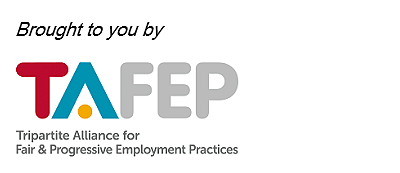Flexible work arrangements are becoming increasingly important to ensure that our workers can remain in the workforce and contribute productively while taking care of family needs.
With the recently launched Tripartite Guidelines on Flexible Work Arrangement Requests developed by the Tripartite Workgroup*, employers and employees must each understand their roles and responsibilities in managing flexible working requests to ensure win-win outcomes.
The Guidelines acknowledge that employers continue to have the prerogative to decide on work arrangements while making it easier for employees to request for flexible working.
The Tripartite Alliance for Fair and Progressive Employment Practices (TAFEP) shares some best practices.
Q: What are flexible work arrangements and why are they important?
Flexible work arrangements are important in creating more inclusive workplaces. With an ageing population and slowing workforce growth, flexible working enables more working adults, including senior workers and caregivers, to continue working or return to the workforce.
There are broadly three types of flexible work arrangements, which are a variation from the standard work arrangement:
1. Flexi-place
Employees work from different locations outside their usual office premises. Examples of these include working at home or in another location for all or part of their workweek.
2. Flexi-time
Employees customise their work schedules to complete tasks without adjusting their total work hours or workload. One example is staggered working hours where employees can start and end work earlier.
3. Flexi-load
Employees are assigned different workloads and compensated accordingly. This can include job sharing or part-time work.

Q: How do you implement flexible work arrangements?
By responding to employees’ needs for flexible working, employers gain access to a larger talent pool and retain valuable employees who require the flexibility to continue working for their employer amidst a tight labour market.
They can now use the Guidelines to help them assess such requests properly and implement them effectively, beginning with these steps:
1. Allow employees to request for flexible working
Today, many employers and employees might already engage in either formal or non-formal discussions about their work arrangements. Such practices should continue if they work well and foster trust and reciprocity at the workplace.
Employers are encouraged to have a flexible working policy covering the following:
- Types of flexible work arrangements available
- Reasons why certain job roles might not be suitable for specific arrangements
- Examples of why requests might be rejected
- Expectations on responsible use of flexible work arrangements
Employees should follow the Guidelines in making requests for flexible work arrangements responsibly. This helps maintain harmonious employment relations as both employees and employers can discuss work arrangements that can meet the needs of both parties.
2. Evaluate all requests properly
In evaluating requests for flexible work arrangements, employers need to consider the impact on the employee’s and team’s workload and performance, as well as the broader impact on business goals and stakeholder relationships.
Employers have the prerogative to reject employees’ requests for flexible working, but this should be based on reasonable business grounds.
3. Communicate timely on the outcomes of requests
Employers should provide a written decision within two months of receiving a formal request. If approved, this decision should outline work expectations of the employee.
Otherwise, explain the reason(s) for the rejection and, if possible, discuss alternative arrangements.
4. Explain clearly the expectations on using flexible work arrangements
Eligibility criteria, along with work expectations such as workload requirements, performance targets and response times for using flexible work arrangements, should be clearly explained to employees.
One way to monitor the effectiveness of the flexible arrangement is to schedule regular reviews of job performance between supervisors and employees.
TAFEP offers monthly briefings and regular workshops to support employers in implementing flexible working for employees and adhering to the Guidelines. Employers can also visit the TAFEP website for more resources on flexible work arrangements.
* The Tripartite Workgroup on the Tripartite Guidelines on Flexible Work Arrangement Requests, which includes representatives from the government, National Trades Union Congress (NTUC), Singapore National Employers Federation (SNEF) and various professional bodies, was convened in September 2023 to develop guidelines to facilitate the implementation of flexible work arrangements.


